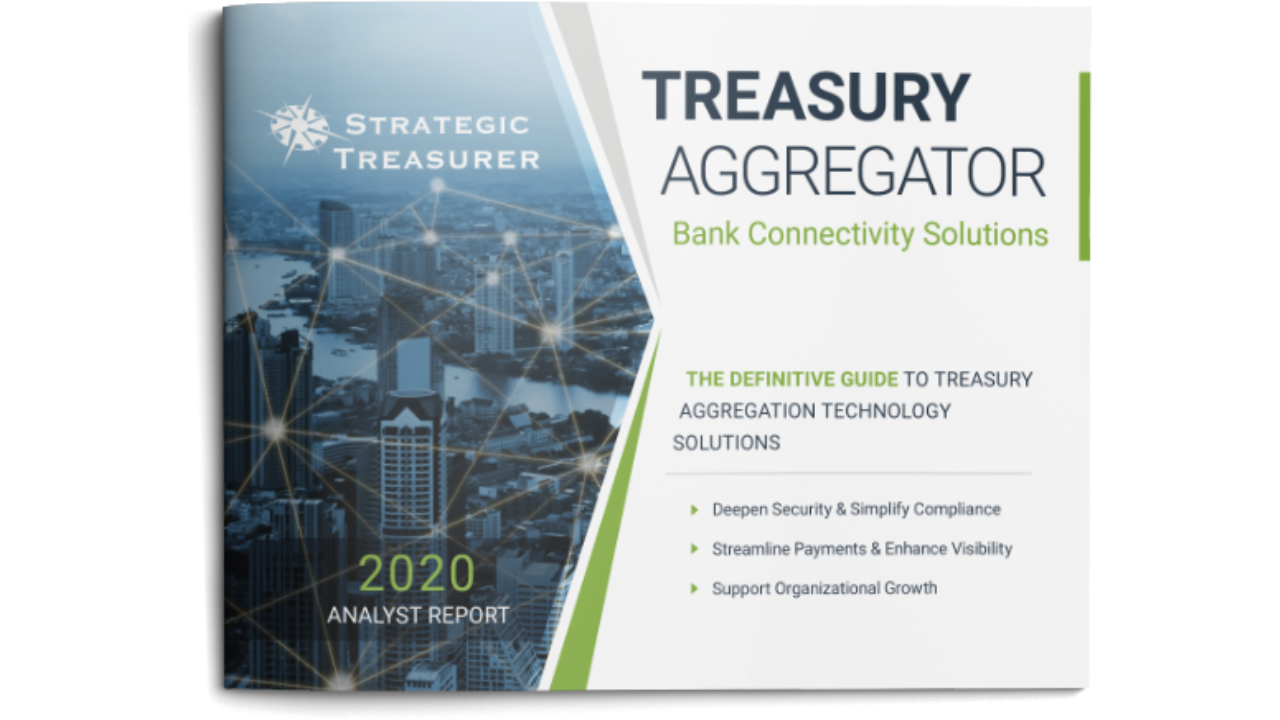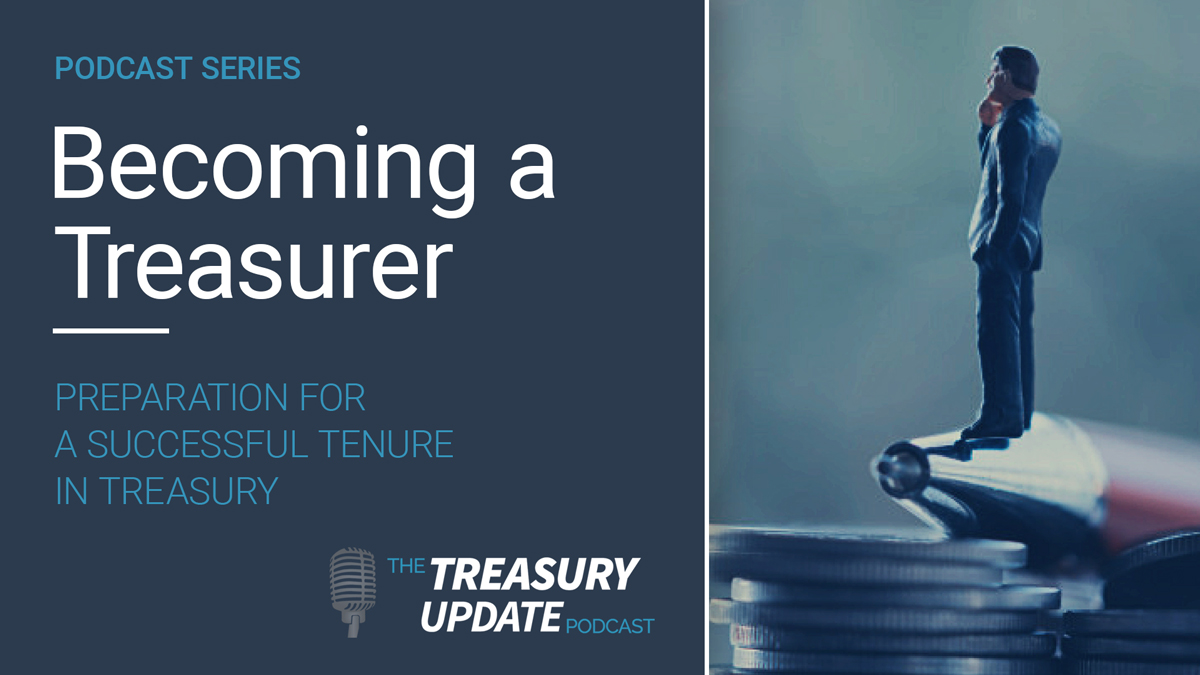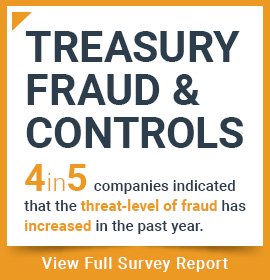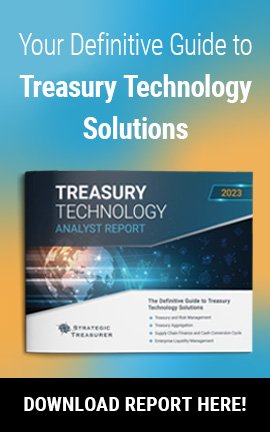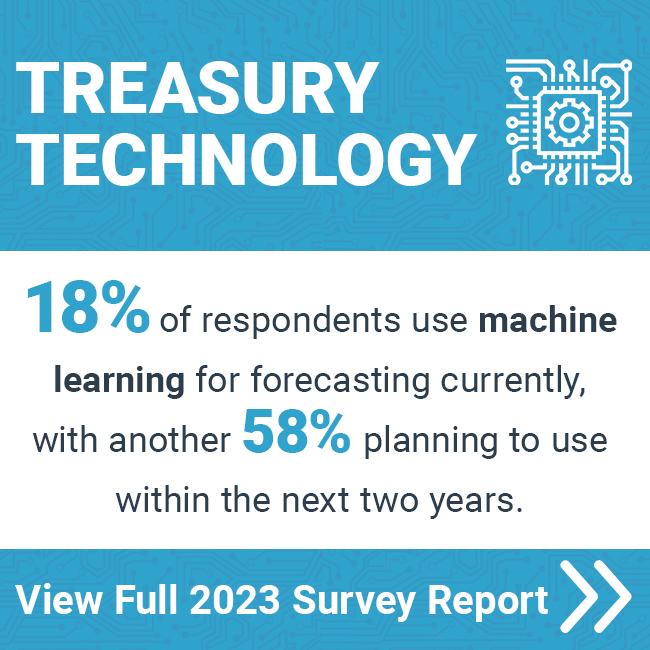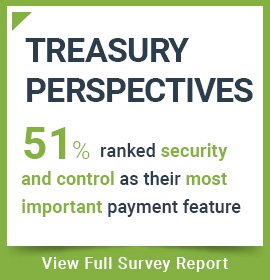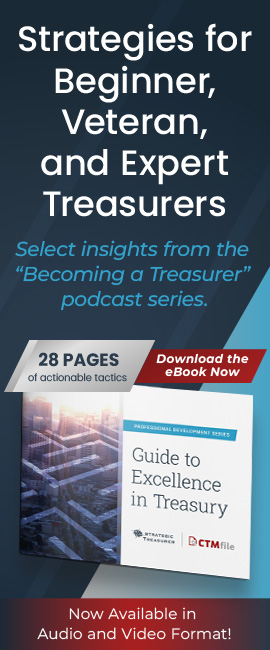
Episode 143
Fintech Analyst Report Series – Part 2: Treasury Aggregator
On this second part of the Treasury Update Podcast’s Fintech Analyst Report Series, Special Host Meredith Zonsius sits down with Managing Partner Craig Jeffery to discuss key takeaways from the 2020 Treasury Aggregator Analyst Report. They cover the pain points driving this technology, bank connectivity solutions, leading practices and more. Listen in to the discussion and enjoy the entire series.
Download the report here.
Host:
Meredith Zonsius, Strategic Treasurer
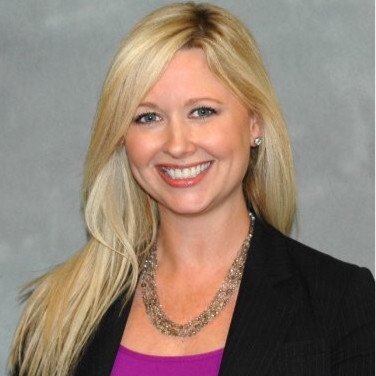

Speaker:
Craig Jeffery, Strategic Treasurer


Episode Transcription - Episode #143: Treasury Aggregator
Meredith Zonsius:
Welcome to the Treasury Update Podcast presented by Strategic Treasurer. Your source for interesting treasury news, analysis, and insights in your car, at the gym, or wherever you decide to tune in. On this second segment of Strategic Treasurer’s Fintech Analyst report series special host, Meredith Zonsius sits down with managing partner Craig Jeffery to discuss key takeaways from this analyst report. They cover the pain points driving this technology, bank connectivity solutions, leading practices and more. Listen in to the discussion and enjoy the entire series.
Meredith Zonsius:
Welcome back to the podcast Craig.
Craig Jeffery:
Meredith, it is good to be here.
Meredith Zonsius:
Craig let’s kick off the discussion with a brief background on the Treasury Aggregator Analyst report. What is the purpose of this report and how was this data pull together?
Craig Jeffery:
The Treasury Aggregator Analyst Report, I think we’ve been running this for about five or six years, we named the category in the past, this idea of pulling in bank information, other types of information and being able to deliver that to companies to systems, as well as send out payments using payment hub technologies, the combination of aggregating information in and payment information out as the broad category of this report as a name. But the purpose is to help people understand what that category is, why it matters, when you use it, and some of the developments that exists there. So, when you think about that, the reports, we develop these reports with our own review of the space, what’s developing, what’s happening, where it’s headed, and we also interview, received quite a bit of information from key providers in the space. So, they’ll send in and fill out questionnaires, answer information, so you have a look at some of the leading players and then you have a broad overview of the market and.
Meredith Zonsius:
Perfect, let’s dive into what exactly is a Treasury Aggregator. What does it do?
Craig Jeffery:
Yeah, so I gave a real quick summary in the beginning, but let me explain the two key parts, so the inbound and the outbound. The aggregation of information is initially and primarily on the bank reporting side. Detailed transactions, summary transactions, balance information, so this is a provider that can go and connect to all of their…let’s say a company’s banks, pull in the information in whatever format it comes in, through whatever channel, whether it’s direct through an API, through a network like SWIFT, pull that in, perform any validation completeness checking etc, and then deliver that information to the company in the format, it needs. And that may be more than one format that it needs. It may be going to a treasury system, it may be going to an accounting platform, maybe going to a reconciliation platform, etc. So, it’s a taking all of that and managing all those connections, formats, on the inbound side.
Craig Jeffery:
On the outbound side, you can think of the complexity of companies that are dealing with 10 banks in 50 countries or maybe something, not quite as complex maybe in four countries, three currencies, but they’re also handling a number of different underlying systems they have to generate payments. And there’s different formats they need to send payments out to execute those transactions. So, the payment hub functionality side of a treasury aggregator takes that information, performs different types of validation, whether it’s account validation or sanction filtering, puts things in the right formats, and then ensures that they’re delivered through the proper channel, whatever that is, API, SFTP, through SWIFT, through some other network and takes care of that. It’s a great reducer of complexity for systems and for connectivity.
Meredith Zonsius:
How is it different than a TMS, a treasury management system?
Craig Jeffery:
Two things, one, there are some treasury management systems that are classified as treasury aggregators because of the amount of formats, they support, number of connections to networks that they can manage and their ability to perform the functions of payment hubs and the outbound side. So, there’s an aspect where there can be an overlap of capabilities, but by definition it’s not necessarily the case. All treasury management systems can pull in information, they can support SFTP, they may or may not support connections to all of the networks, they may or may not support certain API activity for inbound information. And then on the payment side they may be great at doing treasury payments, maybe some wire payments, some low value payments, but they don’t check off all the boxes for a payment hub: any format, extra validation, sanction filtering. You know connecting to everything, so there is there is often a difference, there are a few TMS providers that act as a treasury aggregator and there are certainly some specialized treasury aggregators in the market.
Meredith Zonsius:
We know that treasury can be complex and at times operates with limited resources, what are today’s industry challenges, and how can a treasury aggregator help.
Craig Jeffery:
Well, there’s a lot of changes in the in the market, there’s new payment rails coming up, there’s new requirements for security, for sanction filtering, for ensuring that you have the right controls so concerns about fraud are issues, and when you factor that in with the challenges of, I have a maybe multiple ERPs I have maybe some underline admin systems that make payments, I have several or maybe half a dozen systems that need information from bank data, whether it’s balances or transactional data. And formats are changing, they’re moving from you know BAI and MT formats two different types of xml on the inbound side. And a similar set of changes on the payment side new payment rails, not just new payment formats, that means there’s many, many points where changes are necessary and they have to be supported, and so a treasure aggregator provides a place where it simplifies the activity. So, instead of having, and I’ve used this example before, if you have to talk to 10 people you don’t necessarily want 10 phones on your desk. You want a single phone you just punch in a different number to contact the 10 different people and speak in whatever language and communication style you have with them. You wouldn’t want to do that, you wouldn’t want 10 different phone systems, one can work well if it handles the connections and the language that you’re talking in. So, a treasurer aggregators it simplifies the process greatly for many organizations once they reach a certain level of activity, number of banks, number of accounts, for payment types are doing settlement systems they’re using, this can really reduce the complexity of the change that they’re experiencing from the market or from their company growth.
Meredith Zonsius:
Let’s talk a little bit about security. How can an aggregator help guard against fraud and protect against vulnerabilities to help protect information and assets?
Craig Jeffery:
Yeah, that’s a great question Meredith. I’ll just talk about a couple items here, one on the information side and two on the payment hub side. So, you think about information reporting, if I can use an aggregator, if I get daily visibility or real time visibility across all my accounts. I have the ability to spot a fraud or an attempted fraud or the testing of our system earlier. And the faster, I can see that and react to that the less likely it is that while have a loss or that I’ll sustain a loss on an ongoing basis, at a minimum should mitigate the level of loss that occurs.
Craig Jeffery:
So, this information of visibility is power, speed, and its security, so that’s one aspect. The second on the payment side is because I have a process that is secure and connects to the bank or through a network, I have created this secure platform at that point, I have less handoffs where people are accessing files that can maybe all to them there’s less ids that can enact that change and it creates a, call it an out of band process, when designed properly to help support the control there, so this is a….this is explored more in the report and, as we talk about payment security, these are really important items about security. The other fact that the information is not only it comes back readily for treasury prove to see if there’s anomalous activities or activities occurred on a different date. But all that information can also be reformatted or sent to other platforms your accounting system or your reconciliation platform. Where those processes can be done sooner, and you know, as we we’ve talked about before speed matters and fraud prevention fraud detection and control, so it helps him in all of those areas.
Meredith Zonsius:
Who needs a treasury aggregator? Is there a checklist?
Craig Jeffery:
Yeah, I think there’s a, I think there’s a checklist or maybe some guidelines for it. It’s when you reach a certain level of complexity of connections and what you’re doing. So, if you’re new your organization is new, it’s expanding when you start to get to the point where you’re like, “Oh I’m connecting to five to 10 banks”, for example, for information, reporting and I’m sending out three or more payment types, two, three or more banks. Then that becomes something you really want to look at an aggregator to see if that makes sense, or does your ERP handle that? Or does your TMS handle it effectively there once you start to get more and more payments, more and more networks. This is where an aggregator becomes almost the default decision, but if you’re connecting to one bank for wires or two banks for wire payments through a TMS that maybe is not an aggregator. It may be hard harder to justify using an aggregator when you’re only talking to two institutions, it may not be worth the overhead. It’s the, I can have one or two phones on my desk perhaps, that’s simpler versus a really smart smartphone on my desk but those are those are a couple of those areas, but it’s really driven by the elements of complexity, how many backend systems do I have? How many banks, am I connecting to? What’s my activity, how many payment formats? So, when you start to factor all those the level complex complexity quickly moves you into heavy complexity or hyper complexity and you need to simplify that with your technology structure and so treasury aggregators fit a key need there.
Meredith Zonsius:
That’s helpful and it makes good sense. Let’s take a closer look at some of the problems and solutions that an aggregator addresses. What are what are some key issues?
Craig Jeffery:
So, we talked about payment types and different formats and how it, you know that acts as a service to handle that, you know, we, I think we talked about different payment processes, you have multiple systems that create payment processes and you may not have a complete inventory of that. I just remember one customer of ours, when we were reviewing the payment processes, we said how many of you have, so I think we have 23 to 25 but let’s check. And so, they checked and then they kept checking and found their numbers went over 50 across the globe. So that’s a level of complexity that’s important, so it helps address those issues, because you can start routing all of your payments, for example through that platform to be consistent and controls have clear central and comprehensive visibility to it. And it simplifies the number and types of changes, you have to make on your underlying payment generating systems. Some companies have one or two systems, some have dozens and dozens of systems, so those are factors where the treasury aggregator addresses those.
Craig Jeffery:
I think the other area that’s grown a lot has to do with controls and compliance particularly around sanction parties, it says the liability shifted on the payment side to include the paying entity, not just the bank companies are getting more concerned about that I want to make sure I’m not paying sanction parties. And then the validation the vendor validation and banking information validation I want to make sure that we’re not getting ripped off or we’re sending it to the wrong location. So, I validate that type of activity, so that is falling into this range as well. It’s falling into the requirements in the payment control side and it’s becoming more important in the aggregator space. Those are some of the some of the key areas that we that we didn’t cover already.
Meredith Zonsius:
Looking ahead at treasury aggregators, what are the emerging technologies?
Craig Jeffery:
There’s a number and the report is definitely good to look at I guess I’ll say things quickly as quickly as I can say them I guess. Is that networks that connection two different types of payment network simplifies the process, so these the power of a network is in what you can do and how big is the network. And so, when you can start to connect to some of these aggregators, they have large networks that already keep track of payers and information about them and so you’re simplifying that process by leveraging the power of those networks, that’s one.
Craig Jeffery:
The second has to do with tech in the area of application programming interface, API’s, so the growth in the use of API’s is fantastic for businesses and this is being applied and a number of sectors, including aggregators they’re connecting to banks, not just through SFTP or connecting through SWIFT or other networks, but they’re connecting through API’s. They’re leveraging different types of tech to solve the problem of I need 100 percent visibility and I need it in a more timely basis. So, API’s are a big play here. The growth of payments these faster and better payment types and you can make a list of whatever country you’re in, whatever continent you’re on, there’s a lot of new payment types in the US there’s FEDNOW coming on board there’s real time payment same day ACH. You look in Canada, the UK, Australia, every location has new payment types. So, this is a big deal for solving the challenges of coming on board with these new and better payment types. The other thing I’ll look here to, I wanted to make a comment on, is that the issue of business intelligence, market intelligence, you know the idea that data is growing and Treasury and payables professionals and finance needs to manage data more effectively. That data includes payment data, bank information importing data, and we need to be able to look at that across the board. When I say across the board, I mean across systems, not just in, here’s my ERP data here’s my FX trading platform data here’s my treasure management system data, etc, etc. But more companies need access to greater quantities of information, greater source of information. So, all the information that’s coming through an aggregator can be, an is being, repurposed and placed in data lakes or data blobs to access it with different types of reporting tool self-service reporting tools like BI. And this is the value of information is coming more valuable for pulling this together with some insights asking questions and discovering it so big data, business intelligence is another key area there. And I’ll stop there, because I, I can keep going on, but those are some of the really interesting things in in the treasury aggregator and other tech markets too.
Meredith Zonsius:
Let’s turn our focus a little bit to leading practices and implementation, from selection to implementation to use, what are leading practices of a treasury aggregator?
Craig Jeffery:
I think you know when you’re using for implementation or just using it.
Meredith Zonsius:
Any final thoughts on treasury aggregators.
Craig Jeffery:
Sure, I think this idea of “Do we need one?” How do we go about selecting it where’s the value what does this do for us is there’s some components outlined in the analyst report that you have but you know you think about what are, what are you trying to do from an efficiency standpoint from a control standpoint? How is your business changed? Has it become more complex or less complex? How are you handling that? Are you continuing to make incremental changes which, you know, take and I’m just making this up five units of work when maybe you need to make a change that adapts to…you know so each additional change only takes one unit work. It may take putting in a treasury aggregator to get to that point, so you can handle new payment types support different back end systems and change, to simplify your overall technology architecture. These are really important elements and I encourage people to look at it and not fall, I don’t want to say fall prey, but I guess I’ll say that, fall prey to the oversimplification and equivocation of terms like “I need to make payments”. I can do that in my ERP I can do that on my TMS I can do that on the bank portal. What do you need to do when you say you need to make payments and how do you control payments and manage the connectivity? Think about it as, do you have 10 phones on your desk and you’ve got eight or nine translators, who can handle the different languages, you call or do you have a smartphone that handles you know you can dial different places. I don’t mean a smartphone but an intelligent device that helps you connect to different areas that will do the translation for you and ensure you have adequate connectivity across the board. So those are…that’s the broader view of understanding treasury aggregators. And then the idea of you know, making sure you have a view as if I have bank accounts, I need to see all the data. When I do payments, I want to secure a consistent processes that as well controlled that limits the ability to compromise it. And how do I do that? Services like payment hubs which are part of treasure aggregator functions are components that many companies, once they reach a certain size or complexity, truly benefit from.
Meredith Zonsius:
Thanks Craig, this has been another insightful discussion on the fintech analyst reports. How can our listeners download a free copy?
Craig Jeffery:
So, on our site strategictreasurer.com/ars is a location go to download the free analyst report, you can do that today, you can also pull in the other fintech analyst report series in there. There’s no cost to you as a reader to do that, you just fill out some simple information, you can even control how much spam or how much email information we send you, so you can limit it to the topics that are of interest to you, but there’s a… this is a great set of treasury resources, so we encourage everyone to download their copy and point people to that location.
Meredith Zonsius:
Perfect. I look forward to our next discussion Craig. Have a great day.
OUTRO:
You’ve reached the end of another episode of The Treasury Update Podcast. Be sure to follow Strategic Treasurer on LinkedIn. Just search for Strategic Treasurer. This podcast is provided for informational purposes only and statements made by Strategic Treasurer, LLC on this podcast are not intended as legal, business, consulting, or tax advice. For more information, visit and bookmark strategictreasurer.com.
Related Resources
Researching new treasury and finance technology can be overwhelming. Strategic Treasurer has stepped in to help. Explore our definitive guides to the treasury technology landscape and discover detailed, data-based coverage of all three report topics. Download this report and the others in the series today!
This series within The Treasury Update Podcast explores questions around being a successful treasurer. Topics discussed include preparation, what needs to be measured, effective communication, development of a team, and acquirement of resources needed.

